A lush, green lawn is the pride of any home. But if you’ve noticed brown patches creeping across your yard, you’re not alone. Many homeowners panic when their lawn starts losing its vibrant color, assuming it’s dead or beyond repair. The good news? Most brown lawns can be revived with the right care—if you identify the cause early.
In this guide, we’ll explore the most common reasons lawns turn brown, how to determine what’s wrong with yours, and—most importantly—the steps to bring it back to life.
Why Lawns Turn Brown
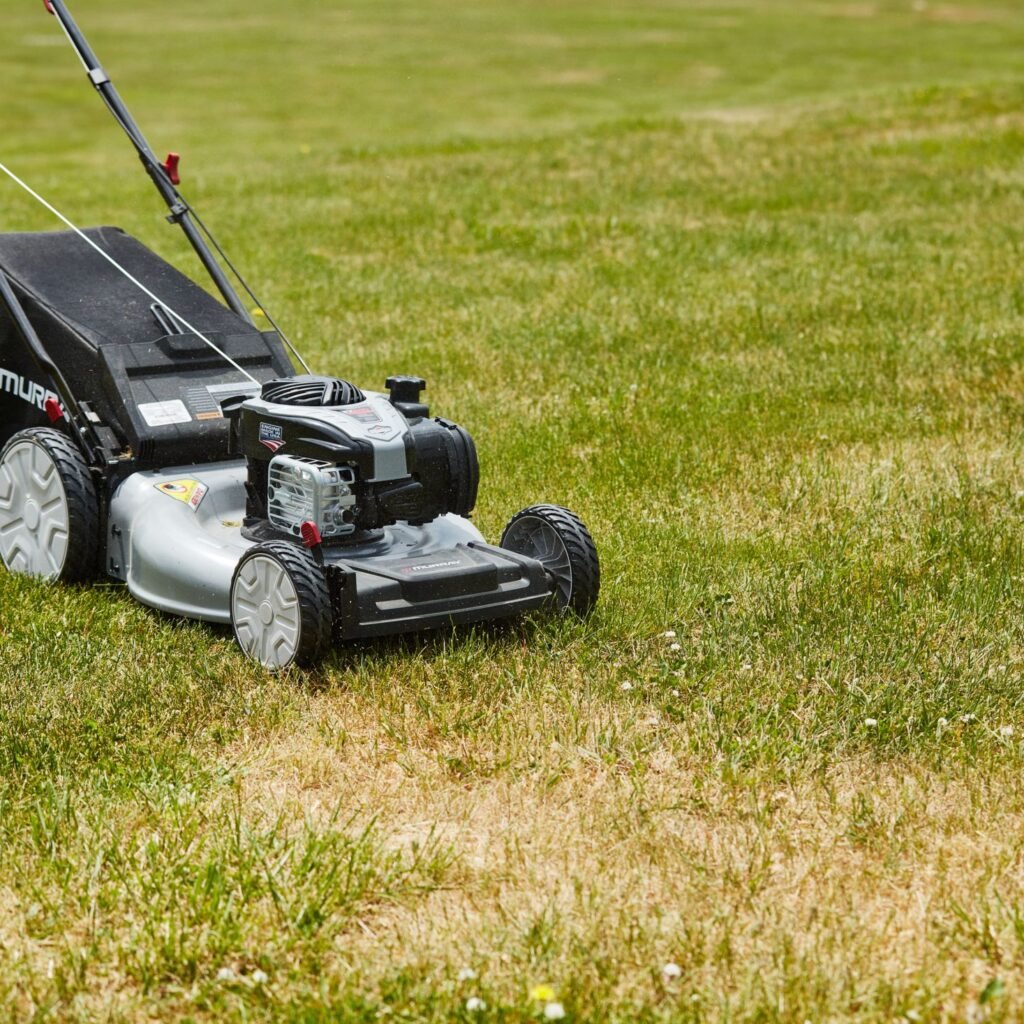
Grass can turn brown for several reasons, ranging from natural cycles to preventable mistakes. Here are the most frequent culprits:
1. Drought Stress
During hot, dry weather, grass often turns brown as a survival mechanism. Instead of dying, many grass species go dormant to conserve water. Roots remain alive but blades lose their green color.
- How to Spot It: Large areas of brown grass during hot spells; soil feels dry.
- Solution: Deep, infrequent watering (about 1 inch per week) can help revive grass. Avoid daily shallow watering, which weakens roots.
2. Soil Compaction
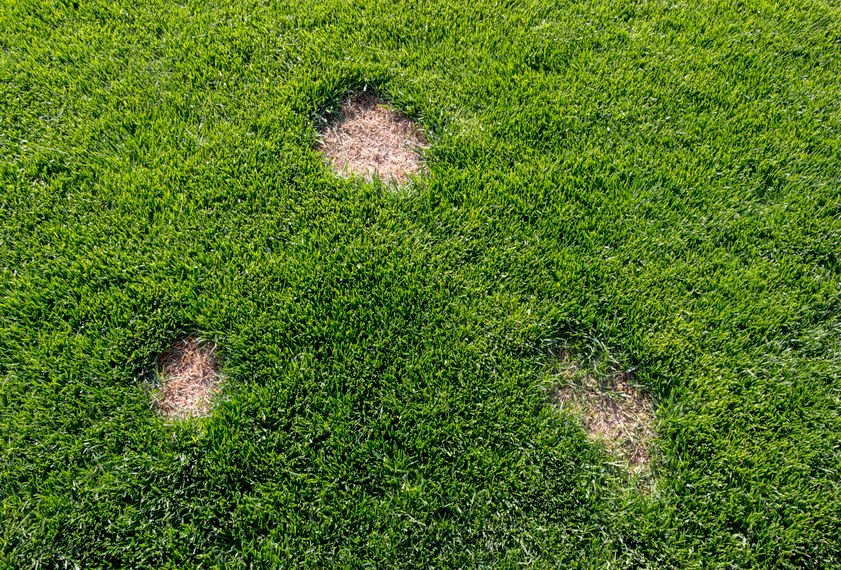
Heavy foot traffic, kids playing, or constant mowing can compact soil, reducing oxygen and water movement to the roots. Grass in compacted soil often thins out and browns.
- How to Spot It: Brown or thinning grass in high-traffic areas; hard soil that’s difficult to penetrate.
- Solution: Aerate the lawn once a year (fall for cool-season grasses, late spring for warm-season grasses). Overseed afterwards to encourage regrowth.
3. Thatch Buildup
Thatch is a layer of dead roots and stems between soil and grass blades. When it builds up beyond ½ inch, it prevents water, air, and nutrients from reaching roots, leading to brown spots.
- How to Spot It: Spongy lawn surface; visible brown layer under green blades.
- Solution: Dethatch with a rake or power dethatcher. Follow up with fertilizer and overseeding to promote fresh growth.
4. Improper Watering
Both overwatering and underwatering can cause grass to brown. Overwatering suffocates roots and encourages fungal disease, while underwatering dries out roots.
- How to Spot It: Mushy lawn with fungal patches (overwatering) or crispy, brittle blades (underwatering).
- Solution: Water deeply 1–2 times per week, ideally early morning. Adjust based on rainfall and climate.
5. Fungal Diseases
Lawn diseases like brown patch, dollar spot, and rust can discolor grass. These usually thrive in warm, humid, and damp conditions.
- How to Spot It: Circular brown patches, discolored spots on blades, or powdery mildew.
- Solution: Improve air circulation by mowing regularly, avoid watering at night, and apply a fungicide if necessary.
6. Pests and Grubs
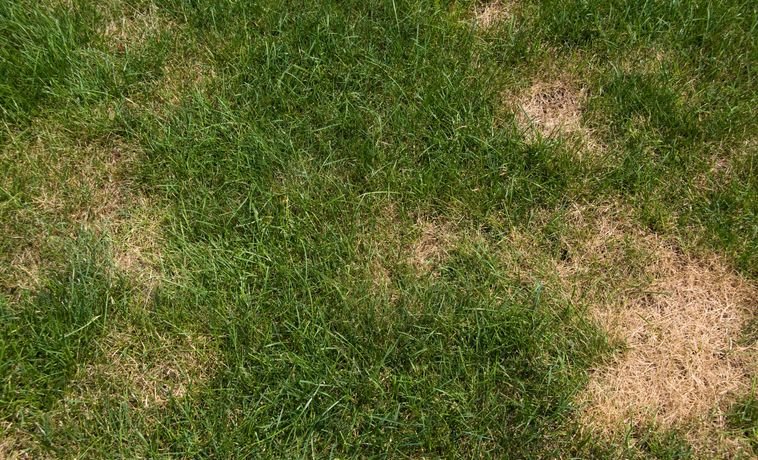
Insects like chinch bugs, armyworms, or white grubs feed on grass roots, causing brown, dying patches.
- How to Spot It: Grass pulls up easily like a carpet (sign of grub damage), or you see insects crawling on the soil surface.
- Solution: Apply beneficial nematodes, insecticidal soap, or a lawn pest treatment. Overseed damaged areas once pests are controlled.
7. Pet Damage (Dog Spots)
Pet urine contains nitrogen and salts that burn grass, leaving brown or yellow patches.
- How to Spot It: Small, irregular spots that are brown in the middle with a green halo.
- Solution: Flush spots with water immediately after pets urinate. Train pets to use a designated area or plant pet-friendly groundcovers.
8. Nutrient Deficiency
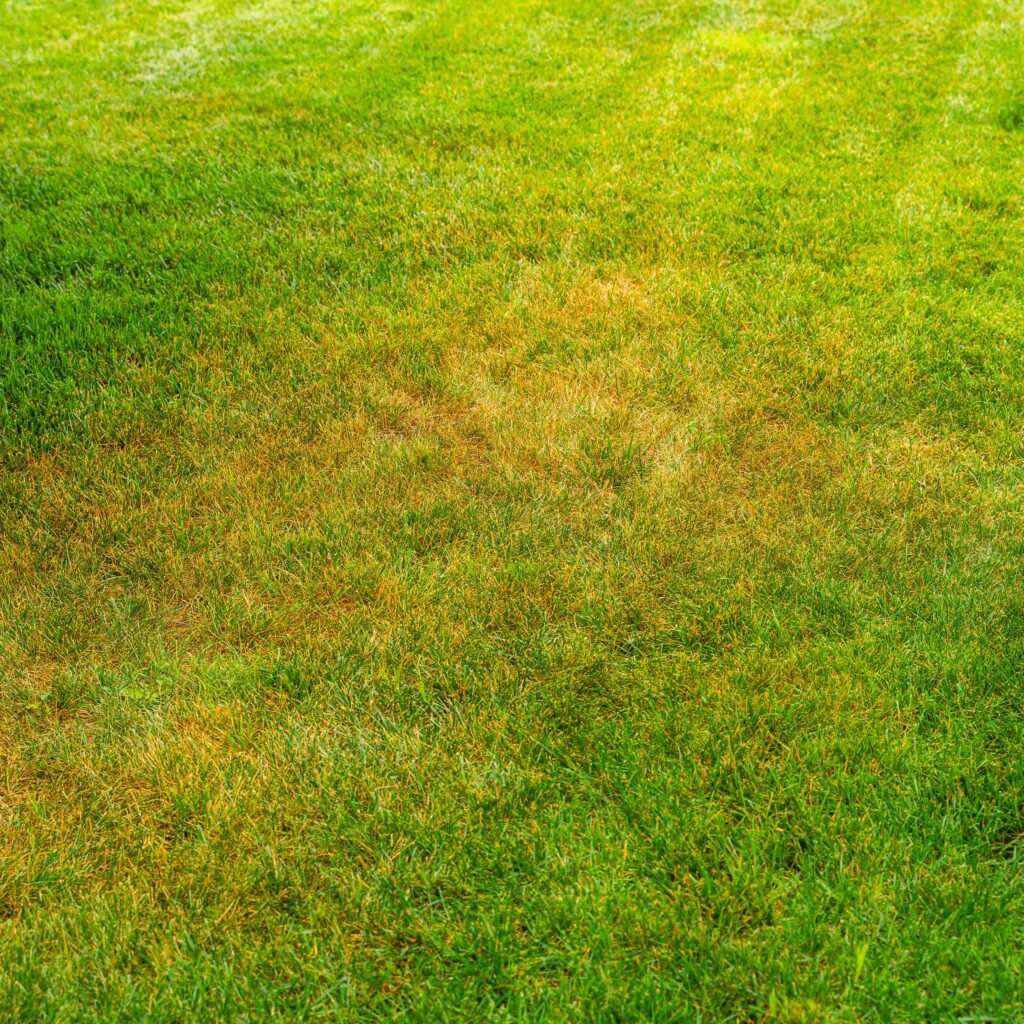
Grass needs nitrogen, potassium, and phosphorus to stay green. A lack of nutrients, especially nitrogen, causes blades to fade and turn brown.
- How to Spot It: General yellowing or browning across the lawn; poor growth despite watering.
- Solution: Apply a slow-release fertilizer in the right season. Conduct a soil test to determine deficiencies.
9. Seasonal Dormancy
Some grasses naturally go dormant and turn brown in response to temperature changes. For example, cool-season grasses brown in hot summers, while warm-season grasses brown in cold winters.
- How to Spot It: Widespread browning that matches the seasonal cycle, but grass revives when temperatures normalize.
- Solution: Be patient. Grass will usually green up again with favorable conditions.
How to Diagnose Your Brown Lawn
Pinpointing the cause of browning is the first step to fixing it. Use this checklist:
- Water Test: Stick a screwdriver into the soil. If it’s hard to push, compaction or dryness may be the issue.
- Tug Test: Pull on the grass. If it lifts easily with no roots, grubs are likely the problem.
- Pattern Test: Circular spots suggest disease, while irregular small patches could be pet damage.
- Seasonal Test: If browning coincides with extreme heat or cold, dormancy is a likely explanation.
Step-by-Step Solutions to Revive a Brown Lawn
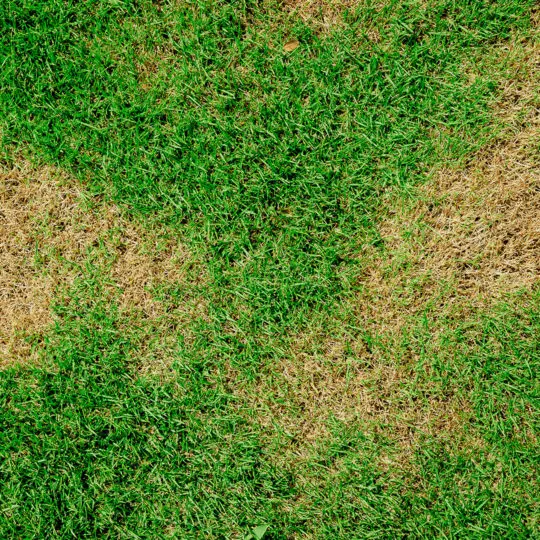
- Water Wisely – Give your lawn a deep soak once or twice a week. Early morning is best.
- Aerate the Soil – Relieve compaction and improve airflow. Follow with overseeding.
- Fertilize Correctly – Choose the right fertilizer for your grass type and season. Avoid over-fertilizing, which burns grass.
- Treat Pests or Disease – Apply organic or chemical controls depending on severity.
- Reseed Bare Patches – Fill in brown areas with appropriate grass seed. Keep soil moist until seedlings establish.
- Adjust Lawn Care Habits – Mow at the proper height (usually 2.5–3.5 inches), sharpen mower blades, and avoid cutting more than ⅓ of blade height at once.
- Pet-Proof Your Lawn – Train pets, rinse spots, or install a gravel area for pet use.
Preventing Future Brown Spots
Prevention is the best cure. Here’s how to maintain a consistently green lawn:
- Follow a Seasonal Lawn Care Calendar – Fertilize, aerate, and overseed at the right times.
- Choose the Right Grass for Your Climate – Warm-season vs. cool-season grasses thrive differently.
- Balance Irrigation – Invest in a sprinkler system or soaker hose for consistent watering.
- Improve Soil Health – Add compost or organic matter annually to enrich the soil.
- Reduce Stress – Rotate play areas, limit heavy furniture on the grass, and avoid mowing when grass is stressed.
Conclusion
A brown lawn doesn’t always mean a dead lawn. More often than not, it’s a sign that your grass needs some attention—whether that’s better watering, aeration, pest control, or a nutrient boost. By understanding the root cause and applying the right fix, you can revive your lawn and restore it to a lush, green carpet.
With consistent care and preventive measures, you’ll not only solve current brown patches but also prevent them from coming back. Your lawn can be the vibrant, healthy centerpiece of your landscape once again.
